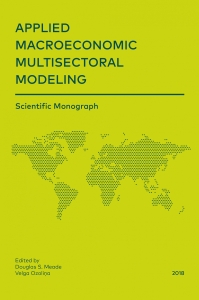Chapter form a Book: Applied Macroeconomic Multisectoral Modeling
Chapter 2: Pads for Russia: Tentative Results
Vadim Potapenko, Institute of Economic Forecasting, Russian Academy of Sciences, The Russian Federation
Scientific Editors: Velga Ozoliņa, Douglas S. Meade
Russian household consumption expenditures have been growing for the last two decades, beginning at the peak of the transformation crisis in the middle of the 1990s, and have become one of the main engines of economic growth. Several times during the period, consumption expenditures slumped abruptly, but every decline was followed by further increase.
At the same time, Russian household consumption patterns have a few intricate and unexpected features. There is a need for a tool that can explore these patterns and features, explain past changes of consumption, and forecast its structure. The tool must cover consumer choice theory and simultaneously allow the user to build a model that takes into account (1) changes of income and the relative prices of goods and services, and (2) substitutability and complementarity of goods and services, and a wide range of other variables.
The Perhaps Adequate Demand System (PADS) proposed (Almon, 1979) and then developed by both the founder of the system (Almon, 1996) and his colleagues (Bardazzi & Barnabani, 2001) is a perfect tool for the task. This paper describes the use of some PADS applications for Russian data and presents its tentative results.
Additional information
| DOI | |
|---|---|
| Publication type | |
| ISBN (print) | |
| ISBN (pdf) | |
| Format | |
| Published online | |
| Publisher | |
| Country of publication | |
| Publication language | |
| Funding source | |
| Copyright |
You must be logged in to post a review.




Reviews
There are no reviews yet.